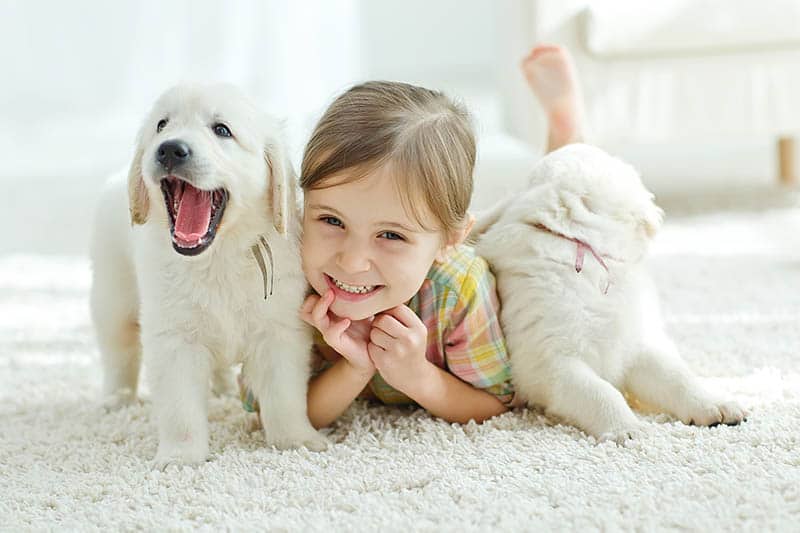Finding good pets for kids isn’t hard, but finding the right one can be a real hassle because there are so many different factors to take into consideration when picking one.
Good pets for kids need to suit both the child and the entire family as well.
This usually boils down to a few factors such as: does the pet fit into the family budget or does it just put too much strain on it; is the pet too high maintenance to add to the plate; are your kids responsible enough to take care of one; the emotional attachment and so forth.
After all, the pet isn’t just some toy that your kids can throw away once they get bored with it. It’s a commitment, one that will likely default to you should your child lose interest and you may not have the time or the desire to take care of one.
And that wouldn’t be pleasant for the pet you decided to adopt. It is, after all, a living being itself.
Many people find it surprising when I tell them everything they need to consider just to buy something simple like a house cat, not realizing just how much there is to think about.
That said, if you can afford one, pets can be amazing companions for your kids and for you. They are also a really good way to motivate your children to get some exercise, to help your kids learn a bit of responsibility, and to get some emotional stress relief if things get tough.
You are more than likely going to form a deep, emotional bond with your pet, much like your kids will, so much so that great pets are likely to be considered honorary family members by many families worldwide.
So, what are the best pets for kids? Let’s find out, shall we?
8 Best Pets For Kids
Once everything has been considered, you are ready to get your kids their new pet, but what are some good pets for kids?
Well, as confident as you may be in your child’s promises, it’s probably good to look at some starter pets that are low maintenance. With that in mind, let’s start with some of the simplest ones that will still appeal to your kids while not causing too much trouble for you.
1. Guinea pigs
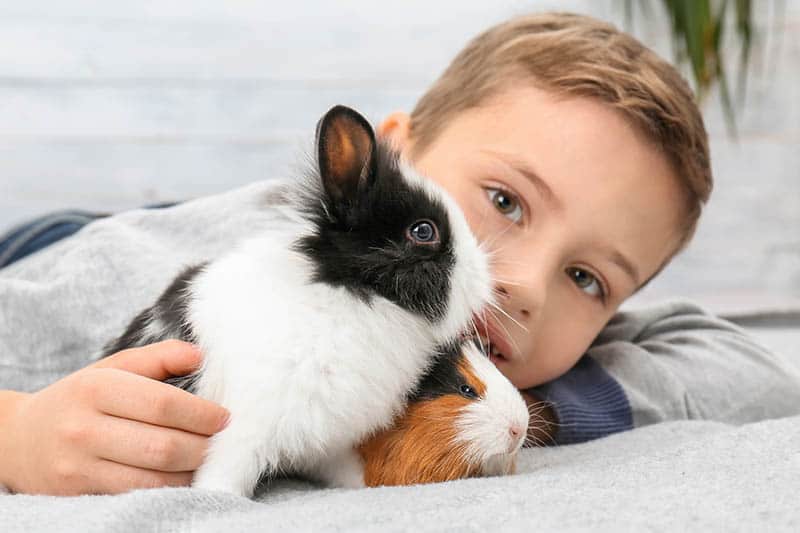
A guinea pig is a delightful little creature that loves being around humans. It’s the perfect pet to start off with as they aren’t too needy and are quite low maintenance when it comes to upkeep costs.
They don’t take up much space, don’t cost much to get, and only eat pellets or leafy greens which is what makes them good pets for kids.
The most effort that your kids will need to put in is making sure their cage is clean and that the wood shavings or the hay that’s strewn around their cage is replaced every now and then.
And the best part is that they aren’t boring pets that are just for display. They’re great to cuddle with or have sit on your lap.
Plus, the very popular hamster wheel can always be installed in their cage too, though it might need a size upgrade from the regular one.
Guinea pigs are very social animals as well.
Not just with humans, but with their own kind too! So, if you find that your child is managing one just fine, you might want to consider getting a second one as well just to keep the little guy entertained when your kid isn’t around for playtime with him.
2. Fish
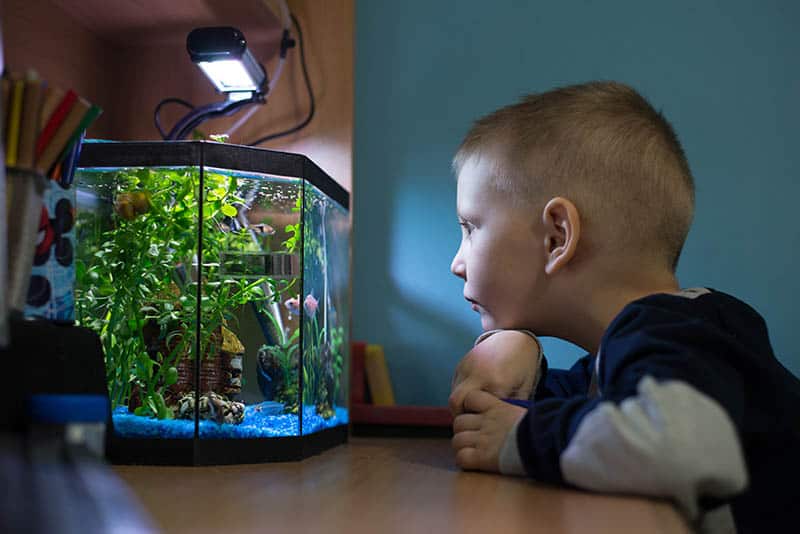
Many different types of fish fit the bill here too.
Two in particular win over all the others if you’re looking for a starter pet though and those are the goldfish and the betta fish also known as the Siamese fighting fish.
The goldfish is a classic pet and a perfect starter for any child. All you need is a small fish tank or even a fishbowl and you’re good to go. That’s because goldfish don’t really need companionship and are just fine being on their own in the tank with no other fishy friends.
Plus, they don’t really need their water to be cleaned very often as they won’t be making too much of a mess.
Fish food isn’t very expensive so that shouldn’t be a problem either.
I would suggest getting at least some decoration for the tank to make it feel more homely, but otherwise, you should be good to go.
As for the betta fish, they require something a bit more sizable, as well as a certain temperature to thrive in, and maybe a friend to accompany them if they’re female because males tend to prefer isolation.
In their case, you are going to need water filters and anything else that will help keep the aquarium clean for them so they survive.
The benefit is that they’re a bigger feast for the eyes than the goldfish is, but ultimately the decision lies with you and your child.
The one real downside is that, more often than not, fish tend to be boring for kids and aren’t really pets to which they’re likely to form a significant emotional attachment, but they should still work out fine as a starter pet.
Plus, if they get bored, the amount of maintenance that you have to end up doing is nearly negligible and the fish themselves aren’t too expensive either.
3. Birds
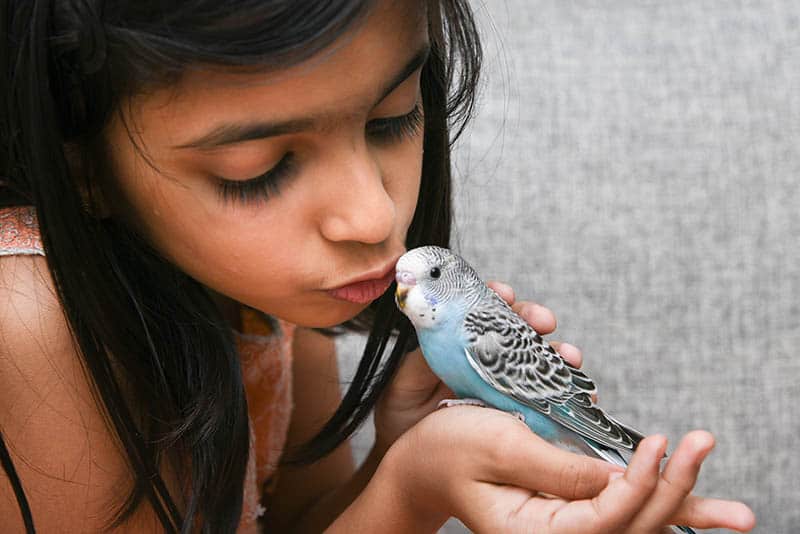
Much like the fish, or well, almost any other type of pet, there are many types of birds to choose from, depending on your budget and intent.
Some people opt for pigeons and ravens, but those tend not to be ideal for kids as they’re rather plain. However, given the surprising levels of intelligence that ravens and crows possess, if your child is interested in training one, they might be the perfect pet!
But, the more common (and more interesting) pet bird is a parrot, with two of the most popular ones being cockatiels and parakeets.
This is because, again, they’re rather low maintenance pets that end up living for a long time, 10-15 years with proper care.
Plus, they’re rather intelligent! They are capable of being taught a few words during their lifespan that they get to use in their socialization with your kids, something that your little ones are bound to find rather amusing.
Outside of their ability to utter words, the parakeet is a bird that comes in a wide variety of colors depending on their origin. This makes them a treat for the eyes wherever they’re seen and it provides a wide variety of choice when your kids get to pick them out at the pet store.
The cockatiel, while lacking in these color combinations, is a precious little dumpling and his yellowy pattern with red cheeks is likely to remind your kids of a Pokemon, which definitely earns the cockatiel some extra points.
Both types also really love to socialize and are likely to perch on the child’s shoulder or their finger if they’re let out of their cage, unlike canaries or some other birds who are rather reclusive and likely to be boring for your kids, despite being good singers.
Their friendly behavior has the potential to help your kid gain a bit more confidence and could help develop your child’s strengths, at least mentally since, as mentioned above, it doesn’t take a lot to care for a pet bird.
The most your kids will have to do to keep their new parrot friend happy is change his water every so often, refill his feeders, and clean his cage, lining it with a fresh new coat of newspapers or something similar.
That said, birds are recommended pets for kids who are 6 years or older, when they’ve learned about a gentler touch and know how to apply it because birds tend to be rather fragile.
And, if your kid succeeds in looking after his pet bird, he’ll get to learn patience and responsibility.
4. Turtles
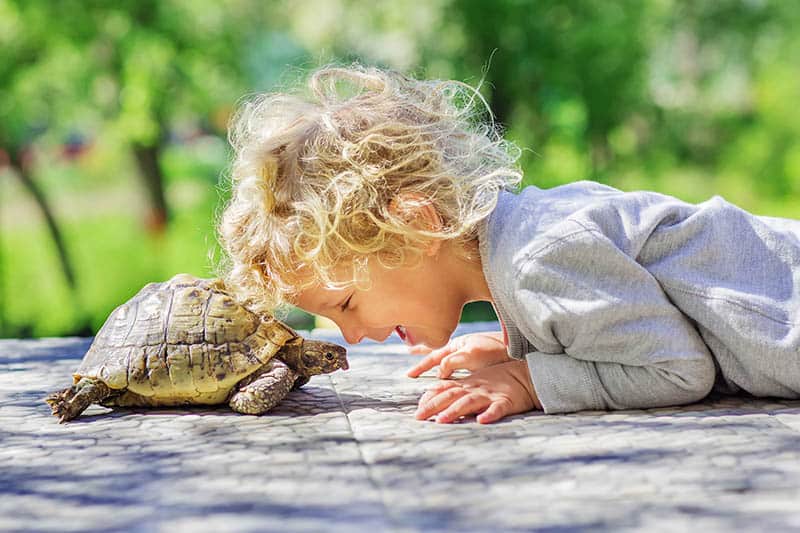
These are a good choice among many different pets, mostly due to their hardiness and long lifespans.
Turtles on their own can handle quite a bit of child interaction while still being completely harmless to the kid playing with him at the time.
That said, you should still make sure to supervise some of these activities for the turtle’s sake and not let the playtime become too extreme.
As for the actual needs of the turtle, they’re low maintenance pets as far as invested effort is concerned, needing only a wide assortment of leafy greens that can be sprinkled around their terrarium on which to thrive.
Though, their preferred diet largely depends on what species they are. Consult the pet shop owner for specifics on keeping one as a pet.
They are quite hungry little guys though so be prepared to feed them often.
The real problem arises when it comes to equipping the terrarium in the first place.
While turtles themselves are cheap to buy, there are many different breeds with many different nurturing techniques required for each one.
Expect to be buying a filter, a heat lamp, and a large tank as a base before even considering the rest. Make sure to consult with the workers at the pet store about any further advice based on the type of turtle that you’re buying.
5. Rabbits
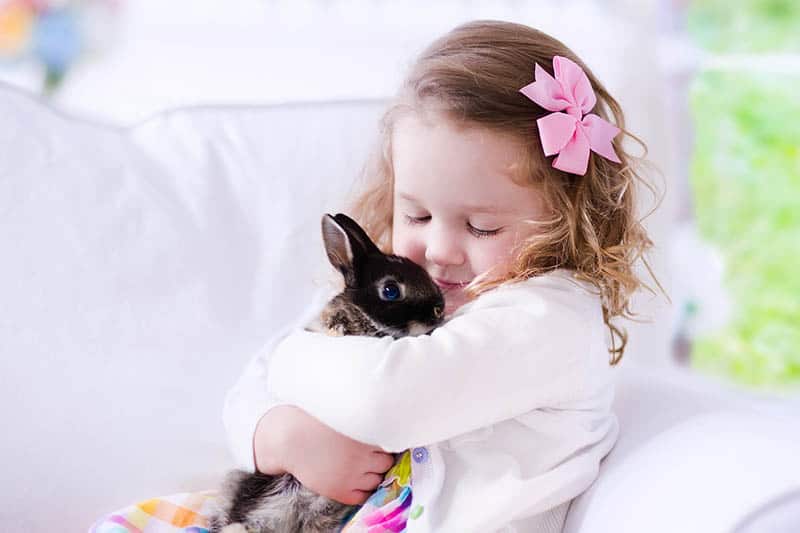
Now, this is a low-maintenance pet that is more suited for older kids who, again, have learned how to be gentle toward other creatures.
Younger kids don’t have that instinct so rabbits, as cuddly, fluffy, and cute as they are, may not have the best time with a child who doesn’t know his limits.
Rabbits tend to live a long time too so you may end up having to take care of him once your kid goes off to college or uni.
But, while your kid is around, he can hold a good portion of the responsibility required to take care of the rabbit, none of it too hard thankfully. It is only a question of feeding the bunny, cleaning his cage, and taking him outside every now and then.
Their one downside is that they’re fragile creatures and they scare easily, so try keeping them away from other animals that may cause them harm.
6. Hamsters

Hamsters are neat little creatures and great transitioning pets when going from fish to something more complex like a dog, but not having the room to accommodate one.
Much like their guinea pig brethren, they require only a cage, a feeder, a water drip, and fresh hay or wood shavings to keep them content, maybe even a hamster wheel but that’s optional.
They’re not greedy with space, but do require a bit of special care about which you should consult the pet shop owner.
The little cuties are a perfect fit for kids who are starting to show good levels of responsibility and who know how to take care of others.
All they’ll have to do is change the hay/shavings every now and then and keep the nourishment coming while the little fluffball rewards you with their cuteness and silly shenanigans as they do all sorts of acrobatics in their cage.
7. Cats
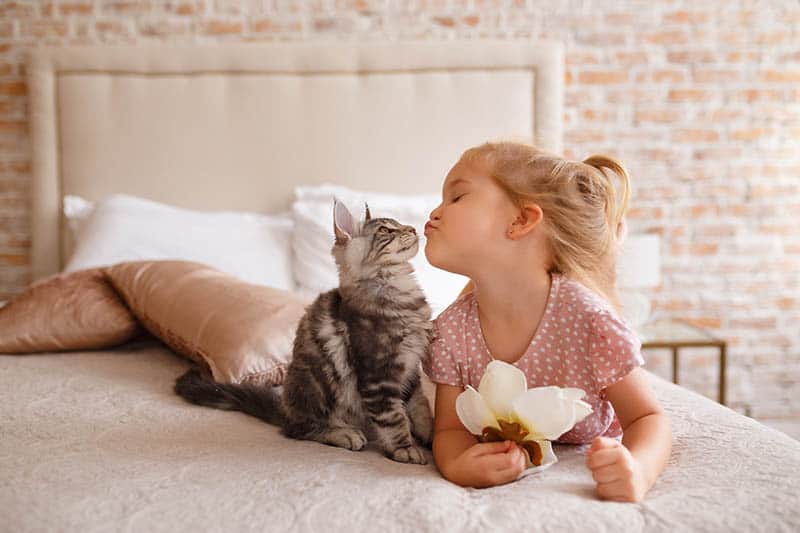
Arguably one of the most popular pets alongside their canine counterparts, cats make for excellent house pets, not just for your kids’ entertainment, but for added utility as well given that they’ll chase away any rodent issue that you may have.
And, if you live out on a farm or in a house, snakes will think twice before approaching a cat’s territory.
If you’re looking for a purebred cat, there are so many different cat breeds to choose from, with the American shorthair being the most common one followed by the Persian and the Siamese.
That said, purebred cats can get rather pricey depending on the breed and you’re probably better off getting a mixed breed from a shelter.
Your kids will love their new pet regardless!
While cats make for the most excellent cuddle partners and also have great entertainment value with their antics every now and again, they come with a drawback or two.
The first one being the fact that your kids may only be interested in them when they’re kittens and might get bored of them once they grow out of their ‘cute’ phase.
That’s a problem shared by both cats and dogs, one that is thankfully not as common as one may think.
The other problem that arises is maintenance costs.
Unlike the fish, the birds, and the guinea pigs, cat food is a lot pricier than that of the other animals mentioned before, especially the wet food.
Then come all the healthcare costs from shots, flea removal treatments, collars, litter boxes, and optional cat toys like scratching posts and the like.
All of that starts adding up to quite the sum making some cats quite high maintenance money wise.
There’s also the necessary cleaning of the litter box and all the fur they’re likely to be shedding which will also require a bit of attention.
But, apart from the monetary issue, the other things are mostly minute if you divvy up the responsibilities in the house evenly. Thankfully they don’t need to be taken out for walks.
8. Dogs
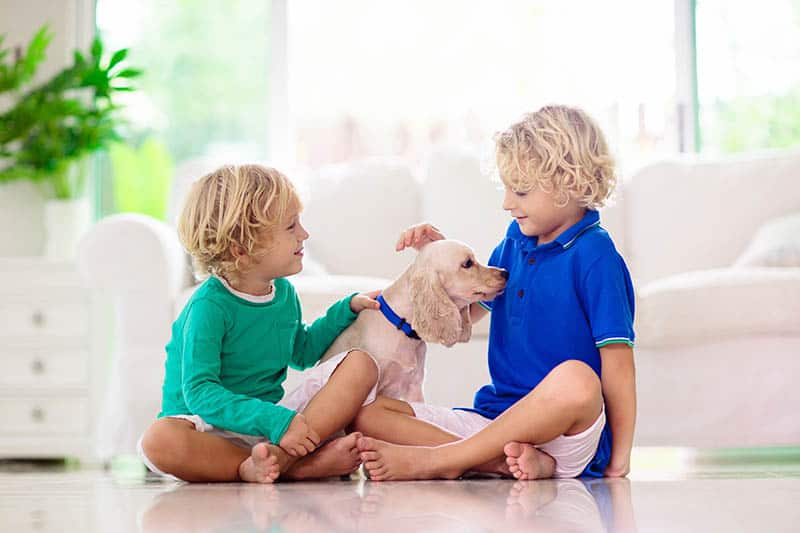
The final entry on my list of good pets for kids is man’s best friend, the dog.
While this may carry a bit of bias given that my very first pet was a dog, dogs make for the best of companions rivaled only by cats.
It’s an age-old feud that ultimately comes down to personal preference, but you can’t deny that it is fun having a large ball of fur to cuddle and play with!
Dogs tend to be quite warm and playful as well as being good-natured by nature(at least some dog breeds).
Plus, many of them are fiercely loyal and tend to exercise great care around their master’s kids which makes them the perfect family pet.
And, much like cats, there are a ton of breeds to choose from, though my personal recommendation is to get a bigger dog if you have the space.
An Irish setter, a shepherd dog, or a golden retriever are especially good choices as those tend to be the most energetic, caring and fun-loving breeds out of the bunch.
If, however, you believe a big dog might be too much for your kids to handle, there are small dog breeds that also fit the bill with three of the best being either a bulldog, a corgi, or a beagle.
The issues related to having dogs as pets, are very similar to those of cats and that’s the maintenance cost of their healthcare, their food, and cleaning up after them.
It also comes with the added responsibility of needing to be taken out for a walk if you don’t have a backyard.
The price of a purebred dog can also be rather steep and you’re better off going to a shelter if you can’t afford the price tag. The dog is likely to be equally as loyal if not more so as you’ve provided him with a home.
EXTRA: Exotic animals

I’ve touched on these before and I wanted to mention them here as well.
Animals like tarantulas, corn snakes, leopard geckos, bearded dragons, and the like are all great but aren’t really child-friendly animals to have around because they tend to require a lot of care and are likely to be something someone in the family is afraid of.
Not to mention the prices some of them end up being and the food that you have to source.
While a neat idea for an older child, you may want to refrain from getting one as a starter pet.
Things To Consider Before Getting A Pet
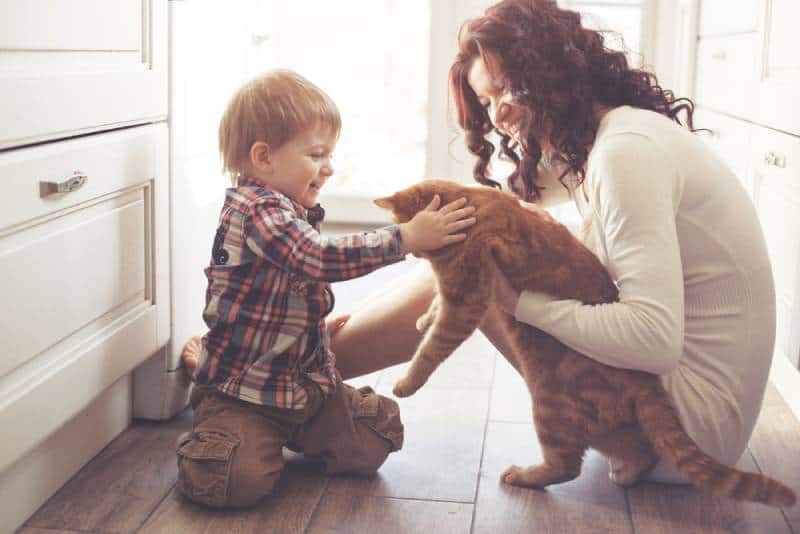
Now, before you go out and buy your family’s first pet, here are a few things that you may need to consider.
A good bit of advice for new parents is that you shouldn’t rush into getting a pet as you may end up with an additional responsibility equal to that of having to take care of another child.
A responsibility that might end up being too much for you.
If it all seems a bit too much for you and you think that you or your family might not be able to cope, please refrain from buying one, for the sake of the pet, your budget, and/or your mental health.
1. The cost
The first thing to consider is the cost of the pet. And this isn’t just a question of being able to afford buying a pet. There are plenty of low-cost pets such as fish, gerbils, and hamsters, but there are also the maintenance costs of having a pet around. Costs that may place too much of a strain on your budget if you’re already struggling.
The pets mentioned above are low maintenance pets, requiring very little money to provide for their feed and accommodation.
This is the case with nearly all small pets outside of some exotic birds which will be more costly upfront but will still have a low maintenance cost.
That said, there are still visits to the vet that need to be considered. Your pet is likely to get sick at some point or may need to be vaccinated annually.
All of these are costs that you need to think about that you may or may not be able to afford for bigger pets.
If finances are your biggest concern, then get a small pet, one that won’t cause you too much trouble or have any potential of causing material damages, whose food doesn’t cost a lot, and who doesn’t have a very long lifespan.
This is why hamsters, gerbils, guinea pigs, and all other animals from the rodent family are quite ideal (plus, they’re great to cuddle with too), as well as some of the more common bird species and fish.
RELATED: Pet Budget: The Cost of Owning and Managing a Furry Friend
2. Child safety
If you have small children, it might not be the best idea to get a pet that is vulnerable to your child’s “exploration” of the world.
Some kids just don’t have a switch that controls what’s okay to do to an animal and what isn’t and they’re likely to cause them some real harm.
Alternatively, getting too big a pet or one that’s prone to being dangerous poses a huge safety hazard for your kids, one that may be too high a price to pay should something bad happen. Think large dogs that aren’t known for their friendly nature or animals that aren’t properly trained.
Even some smaller animals can be pretty dangerous, especially if your kids or even you insist on getting an exotic pet breed like a spider or large snake. It’s not the most pleasant thing to face if it gets out and is scared.
3. Phobias
If you, your kids, or your partner have a phobia of a certain type of pet, then the answer is simple, don’t even consider getting that pet.
There is no need to instill terror into any member of your family just because your kids are insisting on getting something like a spider, snake, or dog.
To be sure, ask all of your close family members whether or not there is a certain animal that they’re afraid of before you go out to the pet store to browse for a new “family member”.
4. Pet’s living space
If you’re considering getting a dog or a cat, do you have enough space to keep them around?
Cats are a bit more manageable since they can nest anywhere you put a basket (even though they’ll sooner choose a box than the bed), but dogs are a whole other story, especially some of the larger dog breeds.
If you don’t have a backyard, chances are that you’re going to have an issue on your hands with a large dog parading around the house.
Plus, the bigger concern is that they’re likely to feel cramped if you have a small living space, as will you when you end up tripping over your dog if he’s lying around on the floor while you’re carrying lunch in from the kitchen.
Luckily small animals don’t have this issue and are easy to house, all you need is to find enough space for a cage or a terrarium and you’re set.
5. A pet’s lifespan
As sad as it is, our pets don’t live as long as we do, even under the most ideal conditions.
You’ll have to take their lifespan into account when thinking about the impact their passing is going to have on your young children, or if they live longer, who is going to have to care for him if your child moves out for university and his dorm doesn’t allow pets.
While the idea of custody does suck, it is yet another factor to consider in all of this and your pet is unlikely to enjoy the idea of separation from either party.
6. The emotional bond
Pet ownership can be a wonderful experience and having the right pet around can immensely improve the quality of life in your home, especially with younger kids as the pet acts as their best friend who always stays around the house for sleepovers and is there whenever they need him.
The hard part comes when it’s time to say goodbye.
As mentioned earlier, most of our pets don’t live nearly as long as we do. It is a sad fact, but one we have to come to terms with.
It can be a hard thing for your child to understand and cope with when their beloved dog passes and explaining it can be tough.
This is where the smaller pets are a disadvantage since most of them only live for barely half a dozen years (and sometimes less) before they pass.
Cats and dogs have this neat middle ground of the average lifespan ranging from 10-15 years which will still hurt when they go, but it will give your kids time to mature and accept their departure from this world in a way that they can process a bit better.
And it’s not only them you have to consider, it’s you and your partner as well. Will you handle the loss of a beloved pet and family member with whom you’re going to have so many fond memories?
It may sound a bit dramatic, but if you can’t, spare yourself the mental stress and emotional scarring and refrain from it.
7. Your child’s wishes
There are two major reasons why your kids may want a pet. The first one is that they’re just looking to have something unique, something that they can show off to their friends, or feel special by parading their bearded dragon or their cockatiel around.
While it may sound selfish, kids with this reasoning generally tend to be more devoted to pet care than the latter because it matters to their image and status, especially older children.
The second reason is simply that your kid thinks it’s fun to have a pet and really would like to get an animal that can be his friend or that he can take care of.
These, while heartwarming and sweet, can be misguided as many kids don’t quite grasp the level of responsibility a pet carries and your child is likely to lose interest in the pet really quickly or shirk their responsibilities.
Should that happen, you’ll end up having to take care of the pet in their stead which, as mentioned before, is probably not ideal for you.
Make sure to make the responsibilities of owning a pet apparent to your child before diving into pet ownership.
8. The need for adult supervision when handling a pet
Finally, you need to realize that adult supervision is a must where young children and pets are involved, both for their own safety and the pet’s as who knows what might happen.
This responsibility lies solely on you and your partner as the parents and should be taken seriously.
In Conclusion
There are many good pets for kids to choose from and it all really comes down to how responsible you believe they can be and just how much you’re willing to spend on one.
Don’t forget to think before buying and especially consider the 10 points listed above as this is a big commitment, not just for your kids, but for the family as a whole.
If you’re budget-starved but your kids insist on a pet, a guinea pig is your best bet.
However, if your budget can handle it, then a dog or a cat are your best go-tos with the dog acting as a bit of extra security if he is a big breed.
Ultimately though, do consider your child’s preferences as this is about making them happy first and be a bit more flexible if you can. I hope you can welcome your new family member with open arms.
Like this post? Please share or pin it for later. You can also stay in the loop and follow us on Facebook, Instagram or Pinterest.

This post contains affiliate links. Please see our full disclosure for more info.

